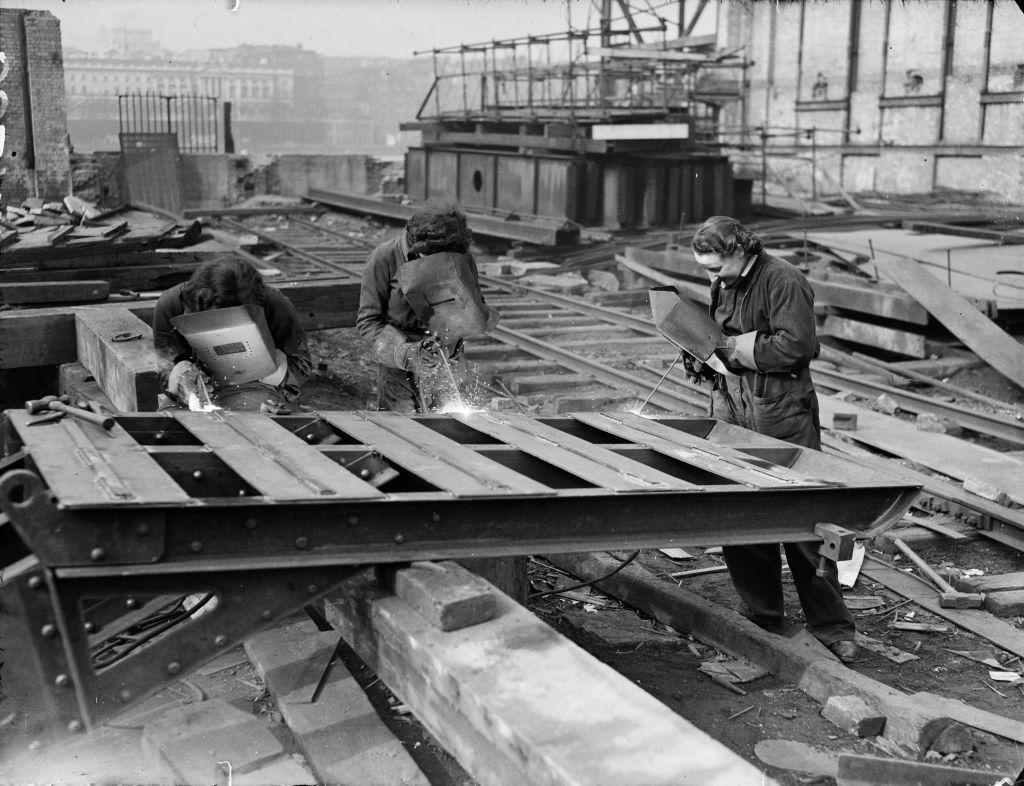December 7, 2024, 7:33 AM
December 7, 2024, 7:33 AM

We know her name, Dorothy. Of his personal history, little or nothing.
But we do know that a photograph that portrayed her in 1944 became an essential piece in recovering a forgotten story: that of nearly 350 women who built the strategic Waterloo Bridge, in the center of London, in the middle of World War II.
The discovery in 2015 of images depicting Dorothy welding parts of the bridge, which spent years gathering dust in an archive at the National Science and Media Museum, confirmed what at the time was nothing more than an urban myth in the English capital.
The material was found by the historian Christine Wall and it became reliable proof of the role that hundreds of women played in the construction of the bridge, in particular, and in the construction industry, in general, during the period of the great wars.
Before that, the idea that Waterloo Bridge had been built by women had been held largely in oral stories.
Thames boaters who passed under its wide concrete and steel arches called it “the ladies’ bridge” (the ladies’ bridge).
But there were no records to prove that these women existed.

It was not until 2005 that the filmmakers Karen Livesey and Jo Wiser began an effort to compile oral histories from some of the thousands of women who participated in the construction industry in those years, which were captured in the documentary The Ladies’ Bridge.
“I remember seeing the women, there were many, I think a few hundred of them,” he says in the documentary David Churchwhose father worked on the construction of the bridge.
But material records of the welders still did not appear, until the discovery of Dorothy’s images.
In his search to find out if this London myth had any reality, Wall found in an archive the photographs that had been published by the Daily Herald and contacted the filmmakers of the documentary to tell them the great news.
Men in front, women on the bridge
The role of women in the First and Second World Wars in various fields that had previously been dominated by men is well documented.
While they were called to the front lines, they assumed tasks as diverse as workers of the factories, ammunition producers or aircraft repairers.
However, female participation in the construction industry (which according to Livesey and Wiser’s documentary reached around 25,000 women in 1941) did not have the same disclosure.
Wall says that when she arrived in London in the late 1970s and managed to enter a construction course, she thought that she and her group were pioneers in that field.
“We thought we were the first to do this, but just 35 years before there were thousands and thousands of women,” she says in the audiovisual piece.
“But there were no traces of them, there were no photographs, there was nothing.”

The story of Waterloo Bridge began long before the world went to global war.
The construction of the first bridge began in 1809. In those years, the structure was known as the Strand Bridge. It was not until after the Battle of Waterloo -where the defeat of the Napoleonic troops took place- that it was renamed in 1816.
By the end of the 19th century the structure’s foundations had been severely damaged by flooding of the River Thames, making it dangerous to the point that a parallel steel structure was erected as a temporary replacement.
That was why the London County Council decided to demolish the old bridge and build a new one.
The design of Waterloo Bridge was commissioned by the architect Giles Gilbert Scott and the works began in 1937. At that time, according to records of the Society of Women Engineers, 500 men were called to work on the construction of the structure.

But in 1939, when World War II broke out, about 350 of them were called to the front lines.
In 1940, when Adolf Hitler’s Nazi Germany was bombing London, it was even considered to suspend the works. But the decision to maintain them became a gesture of resistance on the part of England.
Thus, hundreds of women took on the tasks of welding and splicing of the bridge. In The Ladies’ Bridge, Wall explains that some of them worked long hours and -sometimes- had to protect themselves from the bombings that threatened the city.
As happened in other industries, these women were offered temporary contracts for which they were paid much less than men.
The reasons for forgetting
The reasons why this story was forgotten for so many years are varied.
Wall explains in the documentary that due to the long and exhausting work hours they assumed, the women did not have time to document their experience in personal journals.
This could have served so that – as has happened with other women – her participation in the labor sector during those years was recorded in history much earlier.
On the other hand, the construction company that was in charge of the bridge works was liquidated and, according to its executives, many of the contracts and files were lost in the process.
The daughter of the owner of that company, Betty LindHowever, she was one of those who clearly remembered that when the war came, women supported the work of her father’s construction company.

The fact that the contribution of the welders was not highlighted in the subsequent narrative did not contribute to the fact that records of their work remained.
“The men who built Waterloo Bridge are lucky. “They know that although their names may be forgotten, their work will be a source of pride and utility to London for many generations,” he said. Herbert Morrison at the official opening of Waterloo Bridge in December 1945.
For the women there were no thanks.
A late recognition
Although the salary was not good and the work hours were demanding, the women who took on jobs in different industries in World War II were proud of their work.
When the war ended, according to the documentary, both the government and the men returning home expected the women to also return to their previous roles.
But several resisted.
“I hated those men because I really loved my job.”says one of the interviewees in The Ladies’ Bridge between laughs.
What there is no doubt is that these women made history and that the appearance of photos of one of them allowed their contribution to Waterloo Bridge to be officially recognized for the first time.
After the dissemination of images of the construction of the bridge, in 2015, the Historic England –body in charge of protecting the heritage of England – cataloged the architectural work with degree II protection, that is, it deserves greater care due to the special interest it has at a historical level.
At that time, Emily Gee of Historic England said to the BBC: “These roles (of women) have historically been overlooked, but as research, understanding and awareness reveal them, many fascinating and inspiring stories can be illuminated.”

And remember that you can receive notifications in our app. Download the latest version and activate them.
















